
In the global trade environment of 2025, customs data has become an indispensable tool for foreign trade professionals to accurately develop customers, verify suppliers, and grasp market trends. Faced with numerous domestic and international platforms, from official statistics to enterprise-level bill of lading databases, how should one choose and use them? This article, combining the latest data and practical experience, systematically organizes the eight most commonly used customs data query platforms, providing detailed operation steps and implementation tips to help foreign trade salespersons and teams quickly get started, directly find target buyers, analyze market capacity, and improve development efficiency. Related reading: From 0 to 1: The entire process of foreign trade newcomers using customs data to expand into overseas markets!

Official website: https://stats.customs.gov.cn/ (Statistical data from the General Administration of Customs of China)
Core uses: Official Chinese import and export statistics (monthly/annual), supporting filtering by HS code, trading partner, trade method, place of shipment/place of receipt, etc.; suitable for market size/trend assessment and compliance verification.
When to use it: To conduct overall capacity, trend, and seasonality analysis of China's export/import market; to verify official statistical standards (academic/bidding/compliance).
Quick Start Guide (Practical Steps):
Go to the website → Select "Data Query" or "Monthly Statistical Report".
Enter the 6/8-digit HS code or product keyword in the "Product Code (HS)" field (if unsure, you can search for the corresponding HS code using keywords first).
Select the time range (year/month) and trade method (export/import/re-export).
Export to Excel or take a screenshot for internal analysis.
Usage tips: The official definition is a summary of "declared value/declared quantity", which is suitable for macro-level analysis; if you want to find company-level details, you need to use a commercial detailed database or a third-party data scraping service.
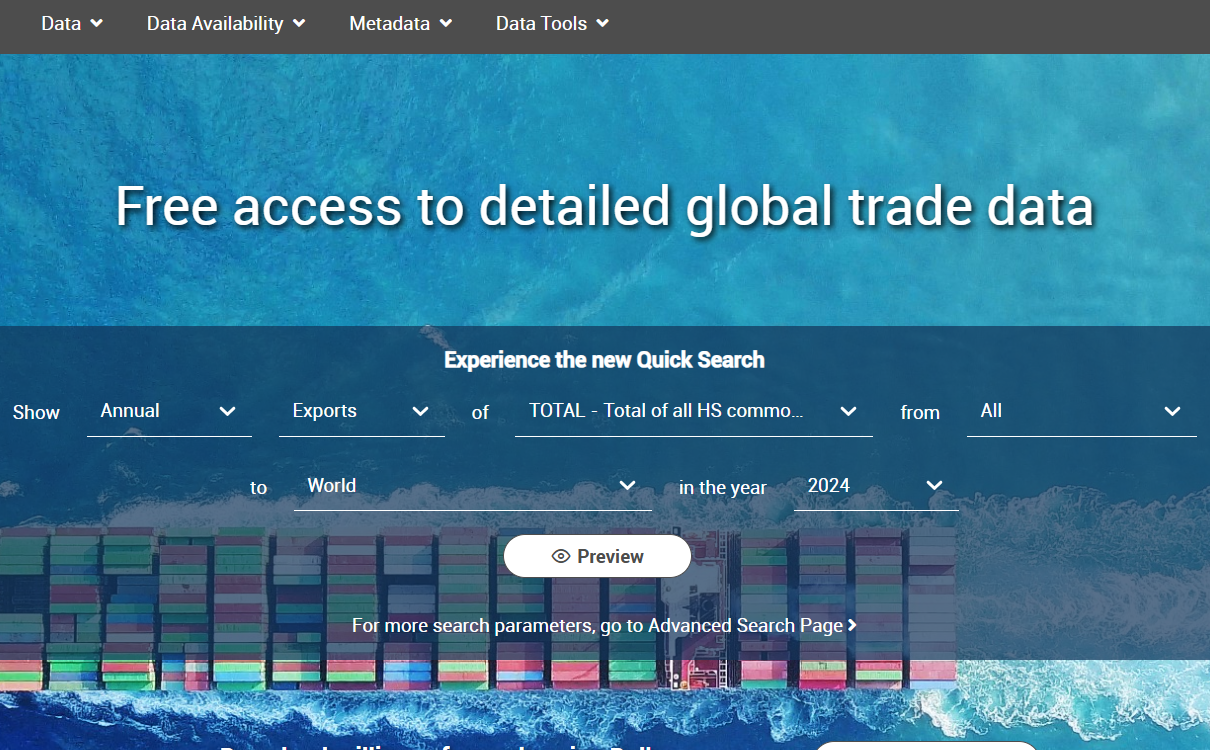
Official website: https://comtrade.un.org/
Core Uses: The world's most authoritative official trade statistics database , covering nearly 200 countries and regions, with historical data traceable for decades, suitable for cross-border comparisons and long-term trend analysis.
When to use: for comparing international market size, macro-level product category trends, conducting trade balance analysis between countries, or for academic/report data.
Quick Start Guide (Practical Steps):
Open COMTRADE → Select “Data” → “Query”.
Select the reporting country, trading partner, commodity (HS), and time period (year or multiple years).
You can choose to output "value (dollar) / quantity (weight)".
Download the CSV or pull it via API (suitable for automated reports).
Usage tips: UN data is a summary of official declarations and does not include enterprise-level bills of lading/cargo owner details; to mine customer lists, it is necessary to use it in conjunction with a commercial customs details platform.

Official website: https://panjiva.com/
Core uses: Provides comprehensive global commercial trade details and enterprise-level leads, excelling in supply chain transparency, competitor tracking, and supplier discovery . The interface features visualization and machine learning-driven matching.
When to use: When you need to find a specific company's import/export records (buyer/supplier/volume/shipping schedule) and conduct due diligence or competitive intelligence.
Quick Start Guide (Practical Steps):
Register and log in (usually a paid subscription).
Enter "company name/product name/HS code/ship name/port" in the search box.
Use filters to narrow down the time, country, and mode of transport (sea/air).
Export company lists, transaction details, or establish monitoring/alerts (track competitors' latest inbound/outbound shipments).
Usage tips: Highly effective for medium to large companies and multinational supply chains; however, if very fine-grained requirements are needed (such as confidential declarations for certain countries), there may be omissions, so it is recommended to cross-verify with other platforms.

Official website: https://www.importgenius.com/
Core Use: Focuses on bills of lading-level data from U.S. Customs (and some other markets), commonly used to find importers/suppliers and monitor competitors' shipping frequency and value . The platform often claims to possess a large amount of data on U.S. companies and bills of lading.
When to use: When the target market is the United States, and you want to directly track the purchasing records and supply chain origins of US importers.
Quick Start Guide (Practical Steps):
Register and purchase a suitable subscription plan.
Use keywords /HS / company name to search, and be sure to select "US import" or "US export".
Browse the B/L (Bill of Lading) section to obtain the carrier, vessel name, shipper, consignee, cargo description, and arrival date.
Export the CSV file and use it as an outbound call list or due diligence basis.
Usage tips: ImportGenius's advantage lies in the B/L details (showing the shipper/receiver); however, translating the "goods description" into HS codes often requires manual verification of keyword matching.
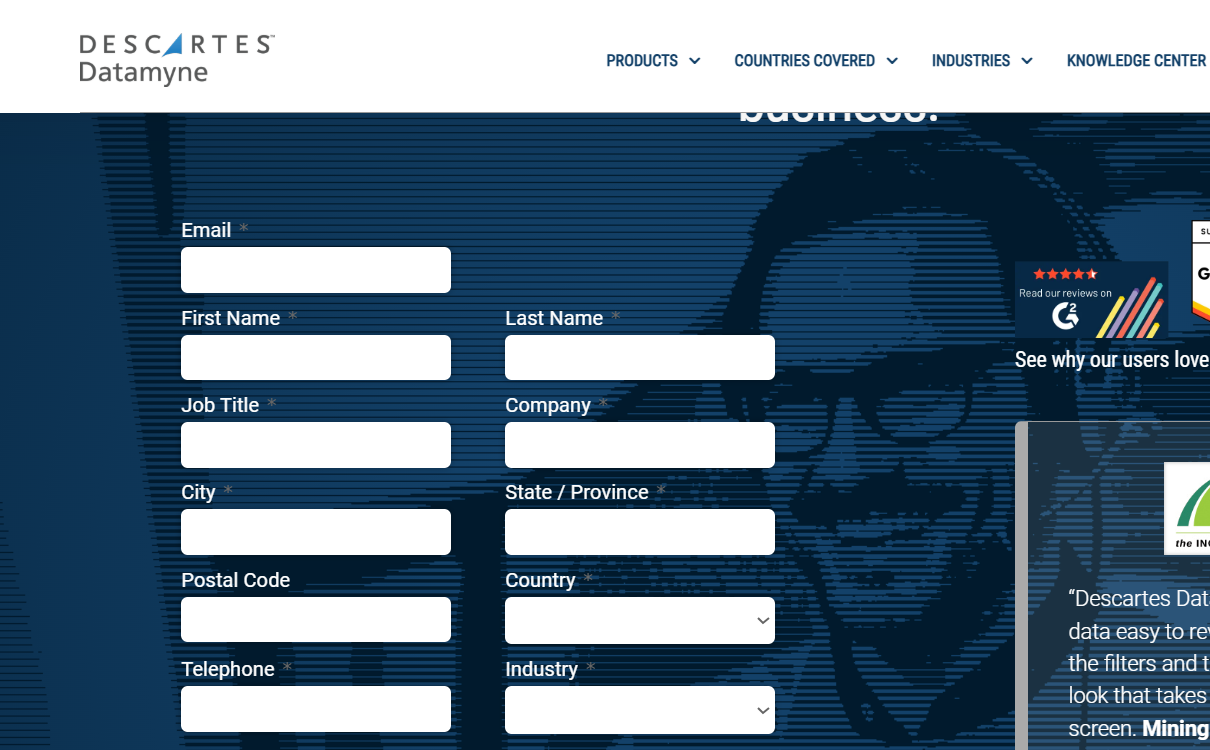
Official website: https://www.datamyne.com/
Core uses: Covering 200+ markets, emphasizing official reporting sources and broad data capture, suitable for enterprise intelligence, channel expansion, and compliance analysis.
When to use: When you need enterprise-level import and export records from multiple countries (including South America, Asia, and Europe) and want the data to be standardized.
Quick Start Guide (Practical Steps):
Contact sales/register for a trial (usually for corporate clients).
Enter the country/HS/company name/time in the platform to search.
Use its data visualization and export capabilities to generate market trends, buyer lists, or shipment volume trends.
Usage Tips: Datamyne has an advantage in data coverage of the Central and South American and Latin American markets, making it suitable for foreign trade companies looking for buyers in these regions.
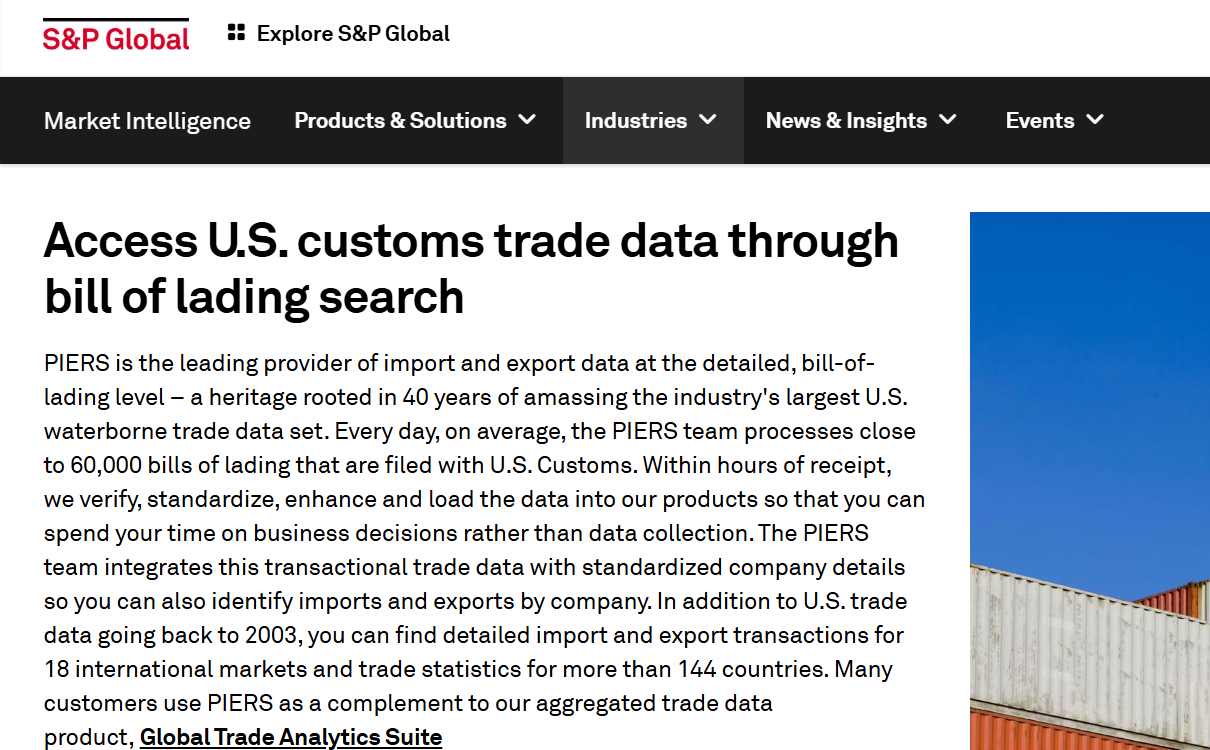
Official website (product page): https://www.spglobal.com/market-intelligence/en/solutions/products/piers
Core application: A bill of lading-level database for US maritime trade (historical data, vessel names, voyages, bill of lading details), which is very valuable for analyzing US/Latin America shipping routes and maritime transport links.
When to use: When serious shipping/port flow data, importer/exporter names, and port traffic data are required (e.g., port analysis, logistics route optimization).
Quick Start Guide (Practical Steps):
Contact S&P/PIERS sales for a demo and quote.
Search for bill of lading entries on the platform by port/cargo owner/vessel name/date.
Export the data for analysis by the logistics or purchasing department (e.g., to calculate a supplier's monthly delivery frequency).
Usage tips: PIERS' advantage lies in its deep and long-term coverage of the US waterborne trade (data from many years can be reviewed), but its prices are usually enterprise-oriented.
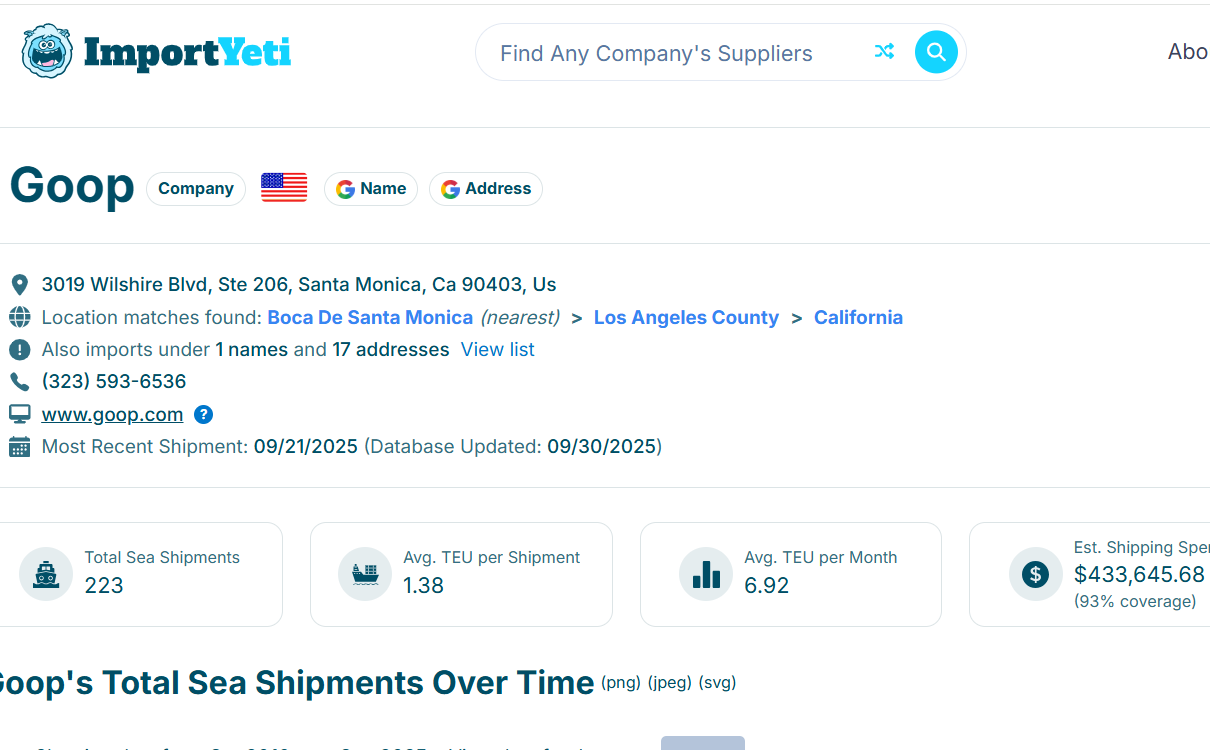
ImportYeti website example (community tools, primarily focusing on US products/bills of lading): https://www.importyeti.com/ (Or access the mirror via a search engine)
ImportKey, RevenueVessel, and others provide SMEs/sellers with relatively low-cost US/EU bills of lading search and list mining. Many emerging alternatives are also available (with significant growth expected in 2024–2025).
When to use: When a foreign trade startup or small to medium-sized team needs to acquire importer leads and supply sources with a low budget.
Quick Start Guide (Practical Steps):
Register (some tools offer free quotas).
Use keywords or HS codes to search and browse company contacts and bill of lading samples.
Export the results for cold chain outbound calls or targeted LinkedIn marketing.
Usage tips: These tools are low-cost and easy to learn, but their coverage depth and data cleaning level vary. It is recommended to cross-validate the consistency of information for the same target on multiple platforms.
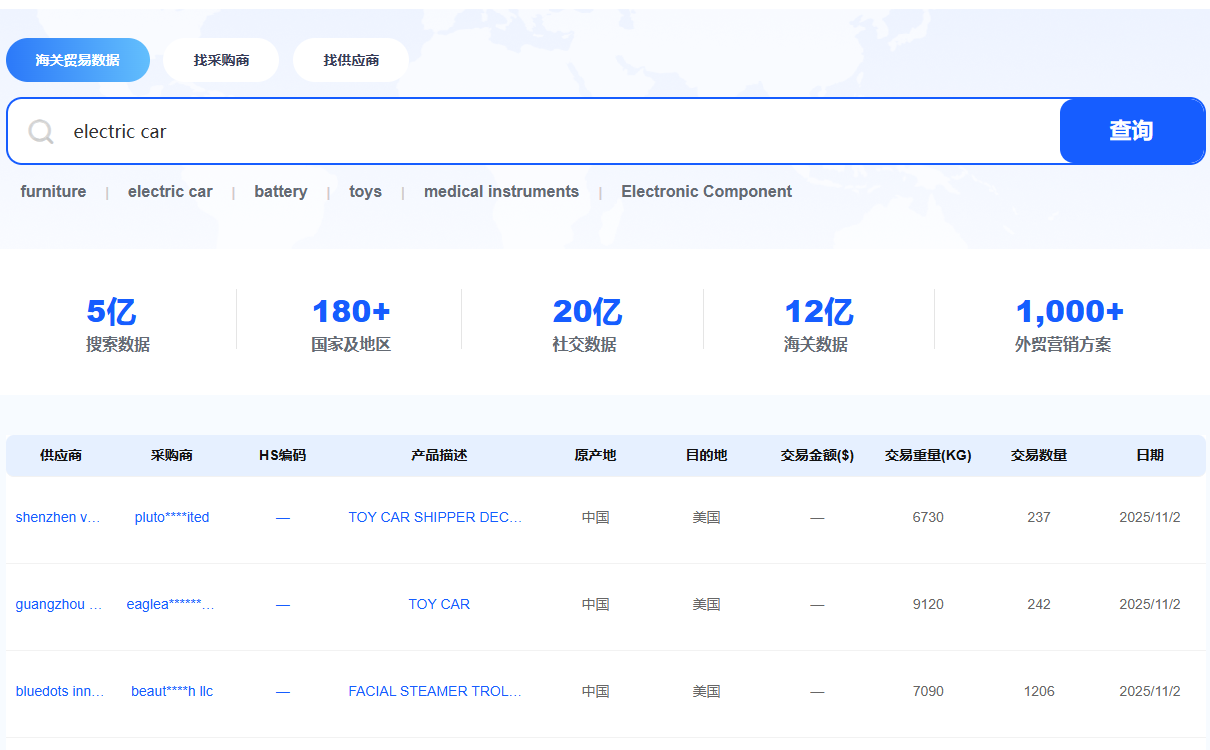
Official website: https://www.cnabke.com/customsData.html (ABke Customs Data)
Core purpose: To provide Chinese foreign trade enterprises with an integrated service of "customs data + buyers/suppliers + intelligent recommendations", covering 180+ countries and regions, and supporting in-depth analysis by product, HS code, and buyer/supplier.
When to use: When you want to quickly generate a list of overseas buyers/suppliers from within China, operate with a Chinese interface, and combine CRM automation in your foreign trade team scenario.
Quick Start Guide (Practical Steps):
Register an AB customer account and choose a trial or package.
Enter "product keywords" or "HS code" in the interface to search.
Use the platform's "Potential Buyers" or "Supplier Recommendations" features to filter by target country, time range, and transaction frequency.
Export the XLS/CSV list, or import it directly into your CRM using the platform's built-in email/phone item links to continue following up.
Usage Tips: Domestic platforms integrate "customs data + contact data," which is highly beneficial for foreign trade teams to directly implement and develop their services. However, attention should be paid to data compliance and privacy regulations (avoiding harassment and ensuring that the laws of the target country allow such outbound calls). It is still recommended to cross-verify the accuracy of the data.
| platform | Main data granularity | Typical price level | Suitable for | Advantages |
|---|---|---|---|---|
| China Customs Statistics (stats.customs.gov.cn) | Country/Product Summary (by HS Code) | free | Policy/Macroeconomic Analysis | Official and authoritative, free of charge. |
| UN Comtrade | Country/Commodity Annual Summary | Free (API has limitations) | Long-term/multinational research | Global coverage, long history. |
| Panjiva | Enterprise-level Bill of Lading/Transaction Details | Enterprise price | Enterprise-level intelligence | Wide coverage and intelligent matching. |
| ImportGenius | US Customs Bill of Lading | subscription model | Targeting the US market | The B/L (Bill of Lading) shows great attention to detail. |
| Descartes Datamyne | Bills of lading and declarations from multiple countries | Enterprise price | International buyers seeking | Multi-country coverage, data standardization. |
| PIERS | US Waterborne B/L | Enterprise price | Logistics/Port Analysis | The US has extensive maritime coverage. |
| Tendata / AB Customs Data | Customs + Contact Person | Monthly/Annual Payment/Package | Chinese foreign trade team | Chinese interface, one-click development. |
| ImportYeti/ImportKey/RevenueVessel | Lightweight Bill of Lading/Company Search | Low price/free trial | Small foreign trade team | Low cost and easy to learn. |
(The "Typical Price Tier" in the table represents market consensus: most commercial platforms charge per user/API/number of exports; free platforms have limitations on the number of exports/fields. Please refer to the official website for specific pricing.)
Search for product keywords or HS (in 6- or 8-digit HS format) in ImportGenius / PIERS / Panjiva .
Filter by "Destination Port/Arrival Time" to obtain a list of buyers for the past 12 months. Export company name, consignee address, and contact person (if any).
Cross-verify company information on LinkedIn and the company website; prepare a customized outreach email (see template below).
Follow-up order: Email —> LinkedIn —> WhatsApp/Phone (if direct line available) —> Send samples.
First Touch Email Template : Concise, Value-Oriented, and Data-Driven
(Using the actual bill of lading number/port/time as an opening line can help break the ice, but don't exaggerate the facts).
Search for supplier company names in Panjiva / Datamyne / ImportGenius and export their export records (time, quantity, and value).
Compare its statements in domestic business registration, credit platforms (such as Tianyancha), and social media/official website.
If consistent shipping records (over six months, with stable buyers) can be found on multiple platforms, the reliability is higher. If it only occurs once a month, be wary of shell companies or trading intermediaries.
Use UN Comtrade + China Customs Statistics to pull the total import and export volume of the target product in the candidate countries and the growth rate over the past 3 years (UN Comtrade compares by country/commodity, and the General Administration of Customs can show the trend of China's shipments to that country).
Focus on the importing country's annual import value, average annual growth rate, and the market share of the top 3 major suppliers. If growth is stable and local substitution is limited, prioritize entering the market.
First, use free databases for verification, then use paid platforms for more refined operations (e.g., UN Comtrade + China Customs for macro-level analysis → use AB Customer Customs data to find enterprise-level leads).
HS codes are crucial : different countries have different codes, so it is recommended to be proficient in using the 6-digit HS code as the primary code, and consult freight forwarders or customs brokers for confirmation when necessary.
Cross-validate company information : The same company may have the same spelling/alias on different platforms. Be sure to verify the information using the address/tax number/phone number.
Do not just look at the "goods description" keyword : the text description of the B/L is not standard and needs to be cleaned in conjunction with HS or machine learning matching tools.
Use export and API appropriately : When regular monitoring is required, choose a paid plan with API support, which can be integrated with CRM automated lead flow.
Data timeliness and latency : Some commercial platforms update more frequently (from hours to days), while official statistics (such as UN) are usually published monthly or annually; the two types of data have different uses.
Privacy and Data Use : Before exporting and using data for marketing, confirm the privacy laws of the target country (such as the EU's GDPR) to avoid violations and harassment.
Single-source bias : Don't draw conclusions based on just one platform. Cross-validation can reduce misjudgments (especially for new suppliers or small batches of records).
With a budget of almost zero (market research/selection) : UN Comtrade + China Customs Statistics (free, official).
Small foreign trade/team (lead development) : ImportYeti / ImportKey / AB customer customs data (low cost / Chinese interface + contact database).
Medium and large enterprises (systematic intelligence and compliance) : Panjiva + Descartes Datamyne + PIERS (API integration and long-term monitoring are available).
.png?x-oss-process=image/resize,h_100,m_lfit/format,webp)
.png?x-oss-process=image/resize,h_100,m_lfit/format,webp)

.png?x-oss-process=image/resize,h_100,m_lfit/format,webp)
.png?x-oss-process=image/resize,h_100,m_lfit/format,webp)
.png?x-oss-process=image/resize,h_100,m_lfit/format,webp)
.png?x-oss-process=image/resize,h_100,m_lfit/format,webp)
